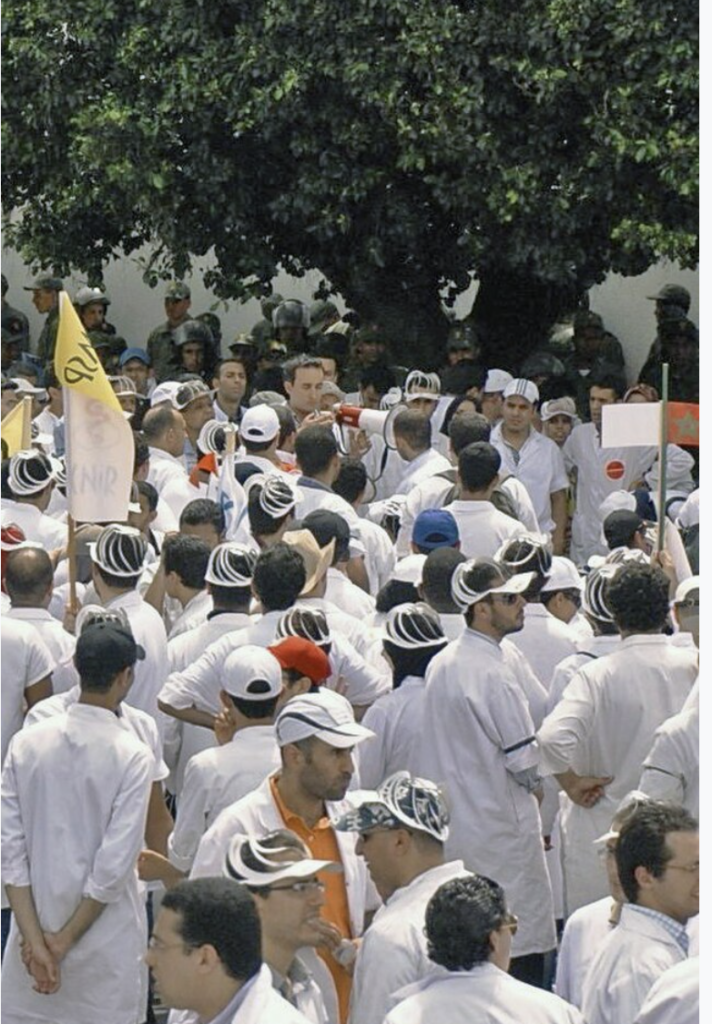Voices of Change: The Fight for Better Conditions Among Moroccan Doctors

By: Rania Basria / Arab America Contributing Writer
In recent weeks, Morocco has been rocked by major protests by doctors, ushering in a new chapter in the fight for better working conditions and resources in the country’s healthcare system. This newest wave of demonstrations reflects growing frustration among medical professionals with the healthcare sector’s chronic neglect, which has left doctors overworked, underpaid, and under-resourced. Rania Basria, Contributing Writer for Arab America, examines the protests, which have received extensive attention both domestically and internationally, and concludes that Morocco’s public health infrastructure needs urgent change.
The ongoing protests by Moroccan doctors, which began in late 2023, are not isolated instances, but rather the result of years of unhappiness with the country’s healthcare system. A number of factors have led to the current increase in strikes and demonstrations. The principal grievance has been deteriorating working conditions. Moroccan doctors, particularly those in the public sector, have long complained about overcrowded hospitals and clinics that are understaffed and short on essential medical supplies. While the COVID-19 pandemic aggravated these problems, it only exposed pre-existing flaws in the healthcare system. Although the pandemic has passed, the underlying structural issues persist, motivating the current protests.
Low salaries are another major source of unhappiness. Despite their crucial role in society, Moroccan doctors are paid much less than their counterparts in other nations. Many doctors, particularly those joining the public sector, are paid wages that do not reflect their years of training or the demands of their field. As a result, many young doctors are leaving the country in search of better chances abroad, where their skills are highly recognized. The “brain drain” has only exacerbated Morocco’s dearth of healthcare staff, creating a vicious cycle that the protestors seek to break.
Doctors have also expressed concern about a lack of funding and facilities in public hospitals. Many healthcare facilities are antiquated, and doctors frequently lack access to critical medical equipment. In certain circumstances, they are forced to direct patients to private clinics for routine operations that should be provided at public hospitals. This is especially troublesome in rural areas, where healthcare facilities are already limited. The discrepancy in access to healthcare between urban and rural areas has long existed, and doctors are urging the government to invest in renovating public hospitals and ensuring that all facilities are sufficiently equipped.
Another significant issue is a shortage of medical workers. Morocco falls significantly short of the World Health Organization’s recommended doctor-patient ratio of one to one thousand. This has resulted in onerous workloads for doctors, who frequently work long hours in high-stress environments, particularly in public institutions. The continuous strikes are partly in response to this overwhelming workload, which physicians claim jeopardizes both their health and the quality of care they can deliver.
The National Union of Doctors has organized a series of protests with specific demands. These include rapid raises in salary and benefits, which doctors feel should reflect the demands and importance of their jobs. The union is also advocating for better working conditions, such as upgraded hospital infrastructure and more medical staff to alleviate the excessive workload. Furthermore, doctors want the government to dramatically boost the healthcare budget, which is now around 5% of the country’s GDP—much lower than the international average. They say that a lack of investment is to blame for many of the healthcare system’s difficulties.
In reaction to the protests, the Moroccan government acknowledged the validity of the doctors’ complaints and promised to implement reforms. The Ministry of Health issued a statement outlining plans to expand healthcare spending, particularly in rural areas, as well as hire more doctors and nurses. However, many doctors remain wary of the government’s promises, noting a history of broken promises. The pace of suggested reforms has been a major stumbling block in ongoing negotiations between the administration and doctors’ unions. While the administration has stated that reforms will take time owing to economic restrictions, doctors are calling for more urgent action to solve the situation.
The protests have received considerable public backing. Many Moroccans rely significantly on the public healthcare system, especially in rural areas where private medical care is unavailable or too expensive. Many voters see the fight for better healthcare as part of a larger push for improved public services, thus the physicians’ demands resonate. However, the protests have disrupted healthcare services in several locations. Non-emergency procedures have been postponed while doctors strike, putting further strain on an already overworked system.
Moroccan doctors’ protests highlight fundamental concerns inside the country’s healthcare system that have gone unsolved for far too long. Their campaign for improved wages, working conditions, and resources is about more than just their own well-being; it’s also about ensuring that all Moroccans have access to decent healthcare. As the protests continue, the reform movement gains traction, serving as a symbol of Morocco’s larger struggle for social fairness and improved public services.
It is unclear if the administration will be able to meet the doctors’ requests and make meaningful changes. However, one thing is certain: Morocco’s physicians’ voices are becoming more audible, and their quest for a better healthcare system has become a rallying cry for reform throughout the country. The conclusion of this conflict could have long-term implications for Morocco’s healthcare system and inhabitants’ well-being.
Check out our blog here!








